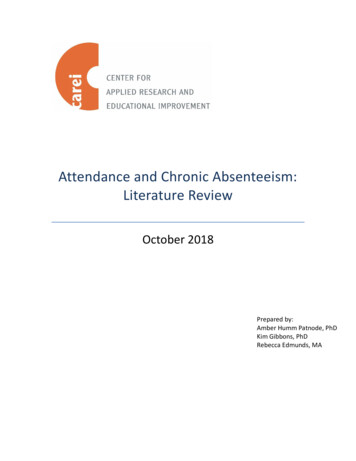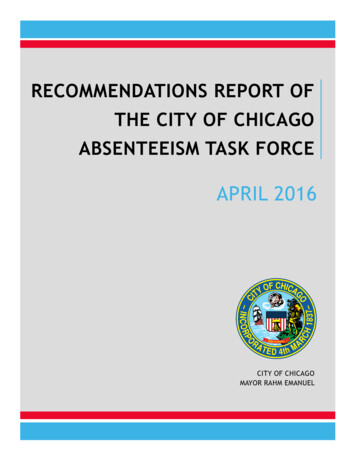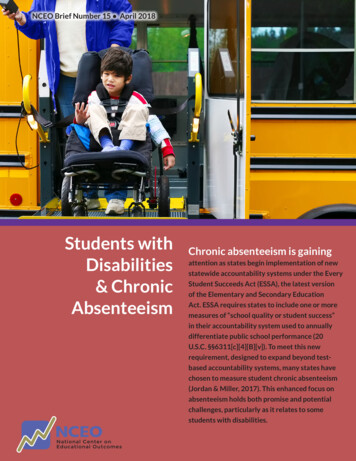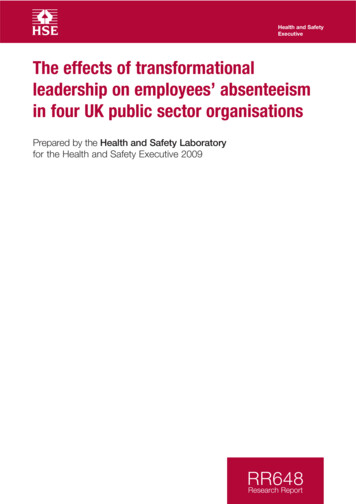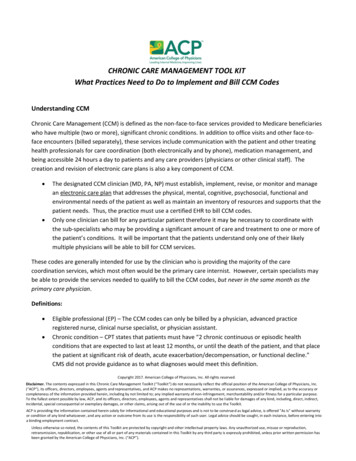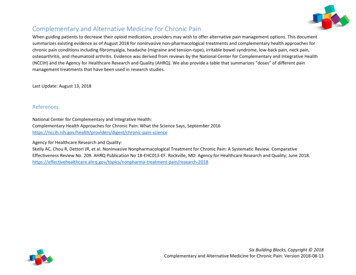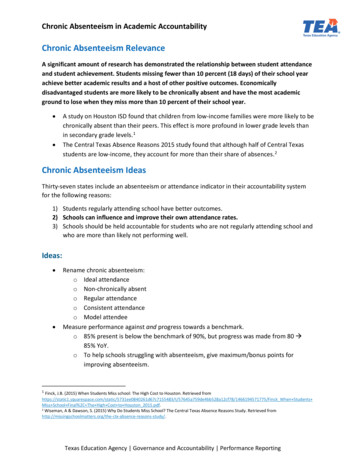
Transcription
Chronic Absenteeism in Academic AccountabilityChronic Absenteeism RelevanceA significant amount of research has demonstrated the relationship between student attendanceand student achievement. Students missing fewer than 10 percent (18 days) of their school yearachieve better academic results and a host of other positive outcomes. Economicallydisadvantaged students are more likely to be chronically absent and have the most academicground to lose when they miss more than 10 percent of their school year. A study on Houston ISD found that children from low-income families were more likely to bechronically absent than their peers. This effect is more profound in lower grade levels thanin secondary grade levels. 1The Central Texas Absence Reasons 2015 study found that although half of Central Texasstudents are low-income, they account for more than their share of absences.2Chronic Absenteeism IdeasThirty-seven states include an absenteeism or attendance indicator in their accountability systemfor the following reasons:1) Students regularly attending school have better outcomes.2) Schools can influence and improve their own attendance rates.3) Schools should be held accountable for students who are not regularly attending school andwho are more than likely not performing well.Ideas: Rename chronic absenteeism:o Ideal attendanceo Non-chronically absento Regular attendanceo Consistent attendanceo Model attendeeMeasure performance against and progress towards a benchmark.o 85% present is below the benchmark of 90%, but progress was made from 80 85% YoY.o To help schools struggling with absenteeism, give maximum/bonus points forimproving absenteeism.1Finck, J.B. (2015) When Students Miss school: The High Cost to Houston. Retrieved 94571775/Finck When Students Miss School Final%2C The High Cost to Houston 2015.pdf.2 Wiseman, A & Dawson, S. (2015) Why Do Students Miss School? The Central Texas Absence Reasons Study. Retrieved e-reasons-study/.Texas Education Agency Governance and Accountability Performance Reporting
Chronic Absenteeism in Academic Accountability o Percentile method would award the most points to a campus that made the mostimprovement.Some states award credit to either students who improve their attendance rate orstudents who maintain a high attendance rate.Chronic Absenteeism and AchievementA significant amount of research has demonstrated the relationship between student attendanceand student achievement. Students missing fewer than 10 percent of their school year achievebetter academic results and a host of other positive outcomes.Chronically absent students are at high risk for several negative outcomes during and after theireducation: Chronic absence in kindergarten is associated with lower academic performance in firstgrade. The impact is two times greater for students from low-income families, who had thelowest levels of achievement in fifth grade. 3One study shows that a record of chronic absence diminishes the likelihood of readingproficiency in grade 3, with 4 percent fewer students proficient in reading compared to theirpeers with acceptable attendance. 4Chronic absenteeism in the early grades is predictive of retention, behavior issues, pooracademic performance, and continued high levels of absence. 5In schools with high chronic absenteeism rates, the achievement of all students isimpacted. 6Negative effects of chronic absenteeism are present in middle and high school, wherechronic absenteeism is associated with lower grade-point averages (GPA), lack of creditaccumulation, and a higher probability of dropout. 7High numbers of absences in grade 6 have been found to be an early warning risk indicatorfor dropping out. 8Chronic absenteeism in grade 9 predicted 77 percent of dropouts. 9Chang, Hedy N and Romero, Mariajosé 2008. Present, Engaged and Accounted For The Critical Importance of Addressing Chronic Absence inthe Early Grades. National Center for Children in Poverty (NCCP): The Mailman School of Public Health at Columbia University. Retrieved oads/2017/06/FINALChronicAbsenteeismReport May16-1.pdf.4Attendance Works. (2014). Attendance in the early grades: Why it matters for reading. Retrieved hen, P. & Rice, C. (2016). Showing up matters: The state of chronic absenteeism in New Jersey: 2nd annual report. Retrieved fromhttps://acnj.org/downloads/2016 09 13 chronicabsenteeism 2ndannualreport.pdf.6Musser, M. P. 2011. Taking Attendance Seriously: How School Absences Undermine 44 Student and School Performance in New York City. TheCampaign for Fiscal Equity, Inc. Retrieved oads/2017/06/FINALChronicAbsenteeismReport May16-1.pdf7Allensworth, E.; Gwynne, J.; Moor, P.; de la Torre, M. (2014). Looking forward to high school and college: Middle grade indicators of readinessin Chicago Public Schools. Retrieved from altimore Education Research Consortium (2011). Destination graduation: Sixth grade early warning indicators for Baltimore city schools theirprevalence and impact. Retrieved from port.pdf.9Allensworth, E. & Easton, J. (2007). What matters for staying on track and graduating in Chicago public high schools. Retrieved as Education Agency Governance and Accountability Performance Reporting
Chronic Absenteeism in Academic Accountability Chronically absent students are also less likely to attend or complete college, with oneanalysis demonstrating that only 11 percent of chronically absent students made it to theirsecond year of college. 10High school dropout perpetuates the achievement gap; 11 for students who dropout, thenegative impact extends into adulthood by lowering their lifetime earning potential, andnegatively affects society as they contribute fewer tax dollars to the economy. 12Chronic Absenteeism and PovertyChronic absenteeism impacts students of all demographics, household income, and academicachievement levels. However, chronic absenteeism often impacts at-risk students the most bycompounding the challenges they face to achieving their educational goals: Elementary school absenteeism is highest in low-income districts in New York and whileattendance rises and falls in every schools, the declines are much deeper in poorcommunities. Schools with high chronic absenteeism face more challenges at thecommunity and school level. 13Based on an analysis of nationally represented data, chronically absent students gained 14percent fewer literacy skills in kindergarten and 15 percent fewer literacy skills and 12percent fewer mathematics skills in first grade. 14One study found that homeless children were chronically absent at almost twice the overallNew York citywide rate – 36% compared to 19% in 2013-14.15A study following student cohorts through high-poverty middle schools in Philadelphia whilecontrolling for teacher quality, prior achievement, behavior, effort, and demographics foundthat chronically absent students had significantly lower odds of closing their mathematicsachievement gaps than their peers who, equally in all other respects, attended schoolregularly.o This same study found that in Maryland, chronic absenteeism rates were threetimes higher among economically disadvantaged students in middle and highschools and at least twice as high in elementary schools. In Nebraska, two-thirds of10Ginsburg, A., et al. (2014). Absences add up: How school attendance influences student success. Retrieved oads/2017/05/Absenses-Add-Up September-3rd-2014.pdf.11 Lara, J.; Noble, K.; Pelika, S.; Coons, A. (2018). Chronic absenteeism: NEA research brief. Retrieved teeism%20NBI%2057-2017.pdf.12 National Educational Association (2008). Preventing future high school dropouts: An advocacy and action guide for NEA state and localaffiliates. Retrieved from .pdf.13 Nauer, K, et al. (2014). A Better Picture of Poverty: Why Chronic Absenteeism and Risk Load Reveal About NYC’s Lowest-Income ElementarySchools. Retrieved from /2017/06/BetterPictureofPoverty PA FINAL 001.pdf.14Ready, Douglas. 2010. Socioeconomic disadvantage, school attendance, and early cognitive development: The differential effects of schoolexposure. Sociology of Education, 83(4) 271-28. Retrieved from 2017/06/FINALChronicAbsenteeismReport May16-1.pdf.15Institute for Children, Poverty, and Homelessness (2015). Empty Seats: The Epidemic of Absenteeism Among Homeless Elementary Students.Retrieved from /2017/12/ICPH-Policy-Report Empty-Seats Chronic-Absenteeism.pdf.Texas Education Agency Governance and Accountability Performance Reporting
Chronic Absenteeism in Academic Accountability chronically absent students are economically disadvantaged and in Georgia, 70percent.o While the causes of chronic absenteeism are unknown, the primary characteristic ofstudents missing a lot of school is poverty. 16Chronic absenteeism is most prevalent among low-income and special education students,or those who stand to benefit the most from regular attendance. In poor rural areas, one infour students can miss at least a month’s worth of school.17The largest differences in chronic absenteeism rates are not between states, but betweenschools within districts. Superintendents and principals must understand and be equippedto address varying absenteeism rates among their schools. 18Chronic Absenteeism and Poverty in Texas A study on Houston ISD found that children from low-income families were more likely to bechronically absent than their peers. This effect is more profound in lower grade levels thanin secondary grade levels. 19The Central Texas Absence Reasons 2015 study found that although half of Central Texasstudents are low-income, they account for more than their share of absences.20A 2015 white paper on chronic absenteeism in San Antonio Schools found that 24 percent ofeconomically disadvantaged students were chronically absent, compared to 6 percent ofthose with no economic disadvantage. 2116Balfanz, R. & Byrnes, V. 2006. Closing the Mathematics Achievement Gaps in High Poverty Middle Schools: Enablers and Constraints Journalfor Educating Students Placed at Risk 11(2) p.143-157. Retrieved from 2017/06/FINALChronicAbsenteeismReport May16-1.pdf.17 Balfanz, R & Byrnes, V. (2012). The Importance of Being in School: A Report on Absenteeism in the Nation’s Public Schools. Retrieved oads/2017/06/FINALChronicAbsenteeismReport May16-1.pdf.18Jordan, P & Miller, R. (2017) Who’s In: Chronic Absenteeism Under the Every Student Succeeds Act. Retrieved from 9/REPORT Chronic Absenteeism final v5.pdf19Finck, J.B. (2015) When Students Miss school: The High Cost to Houston. Retrieved 94571775/Finck When Students Miss School Final%2C The High Cost to Houston 2015.pdf.20Wiseman, A & Dawson, S. (2015) Why Do Students Miss School? The Central Texas Absence Reasons Study. Retrieved e-reasons-study/.21 Speigle, E, at al. (2015) Attendance Matters: White Paper on Chronic Absenteeism in San Antonio Schools. Retrieved ducation-policy/texas/.Texas Education Agency Governance and Accountability Performance Reporting
Chronic Absenteeism in Academic AccountabilityChronic Absenteeism and ESSA, All StatesA chronic absenteeism indicator must meet the followingrequirements to be included in a state’s ESSA plan. All statesalready collect this information, and 37 have decided toinclude it in their accountability system, for the followingreasons:1) Students regularly attending school have betteroutcomes2) Schools can influence and improve their ownattendance rates3) Schools should be held accountable for studentswho are not regularly attending school, and aremore than likely not performing wellTexas Education Agency Governance and Accountability Performance Reporting
Chronic Absenteeism in Academic AccountabilityAlabama Chronically Absent Having 18 or more absences.Alabama ESSA PlanIndicatorAcademic AchievementGrowthELP ProgressChronic AbsenteeismGraduation RateCollege/Career ReadinessAlabama Indicator WeightingsWith Grade 1220%25%5%10%30%10%Without Grade 1240%40%5%15%-Alaska Chronically Absent Absent 10% or more of enrolled days.Schools earn from 0 to 100 points for performance on this indicator, measured as thepercentage of students not chronically absent.Alaska ESSA PlanIndicatorAchievementGrowthGraduation RateEL ProgressChronic AbsenteeismGrade 3 ELAAlaska Indicator WeightingsK-6 Weight15%20%15%10%5%Grades 7-12 Weight30%20%10%10%-Texas Education Agency Governance and Accountability Performance Reporting
Chronic Absenteeism in Academic AccountabilityArizona Chronically Absent Absent 10% or more, or 18 days.o 5 points Current year chronic absenteeism rate is less than prior year’so 5 points Current year and prior year chronic absenteeism rate is 0%o 0 points Current year chronic absenteeism percentage is greater than the prioryear’sUsed in K-8 only.Kindergarten and chronically ill students not included.Arizona Indicator WeightingsIndicatorK-8 WeightProficiency60%Growth20%EL Achievement and Growth10%Chronic Absenteeism10%Drop-OutGraduation Rate-K-8 and 12 Weight60%10%10%10%5%5%California ESSA plan says chronic absenteeism is their additional academic indicator for grades K-8, butit is not on their report cards (might be added after COVID).California’s ESSA PlanColorado Chronically Absent Absent 10% or more of enrolled days. Illness, suspension, excused andunexcused absences are included.o Exceeds At or above the 85th percentileo Meets At or above the 50th percentile but below the 85th percentileo Approaching At or above the 15th percentile but below the 50th percentileo Does Not Meet Below the 15th percentileUsed for elementary and K-8 school types only.Colorado’s ESSA PlanColorado K-8 Schools Indicator Other Indicator (Chronic Absenteeism)16.7%Texas Education Agency Governance and Accountability Performance Reporting
Chronic Absenteeism in Academic AccountabilityConnecticut Chronically Absent Absent 10% or more of enrolled days.o Full points Chronic absenteeism rate 5%o Proportional points Chronic absenteeism rate between 5% and 30%o No points Chronic absenteeism rate 30%All school types include chronic absenteeism.o Elementary Weighted at 10.5%o Middle Weighted at 10%o High Weighted at 6%o Middle High Weighted at 6.8%Texas Education Agency Governance and Accountability Performance Reporting
Chronic Absenteeism in Academic AccountabilityDelaware Chronically Absent Absent 10% or moreChronic absenteeism is included in Delaware’s SQSS indicator, along with other indicators:o SQSS in Elementary and middle schools: Science and social studies proficiency andchronic absenteeismo SQSS in high schools: College and career preparedness, on track for graduation in 9thgrade, and chronic ion RateProgress Toward ELPDelaware Indicator WeightingsElementary & Middle Weight30%40%20%10%High School Weight30%N/A40%20%10%District of Columbia Chronically absent absent 10% or more of enrolled daysSchools receive points based on two options:o 90% not chronically absento Growth in 90% not chronically absent: Student attendance growth percentile forthe median student at a school. This percentile is compared with students who hada similar attendance rate the previous year.Chronic absenteeism is included in the SQSS indicator along with in-seat attendance, reenrollment, CLASS, access and opportunities, AP and IB, and an alternate graduation metric.Texas Education Agency Governance and Accountability Performance Reporting
Chronic Absenteeism in Academic AccountabilityTexas Education Agency Governance and Accountability Performance Reporting
Chronic Absenteeism in Academic AccountabilityTexas Education Agency Governance and Accountability Performance Reporting
Chronic Absenteeism in Academic AccountabilityTexas Education Agency Governance and Accountability Performance Reporting
Chronic Absenteeism in Academic AccountabilityGeorgia Chronically absent absent more 10% or more of enrolled days.Attendance is measured for elementary, middle, and high schools.Georgia’s ESSA PlanTexas Education Agency Governance and Accountability Performance Reporting
Chronic Absenteeism in Academic AccountabilityHawaii Chronically absent Absent 15 or more days.Excused and unexcused absences are included.Included for middle and high schools.Hawaii’s ESSSA PlanTexas Education Agency Governance and Accountability Performance Reporting
Chronic Absenteeism in Academic AccountabilityIllinois Chronically Absent Absent 10% or more of enrolled days, regardless of the reason.o Every student enrolled at least 10 days is included.Kindergarten not included.IndicatorELA ProficiencyMath ProficiencyELA and Math GrowthEL ProficiencyScience ProficiencyChronic AbsenteeismClimate SurveyP-2 IndicatorCollege/CareerReadinessth9 Grade on TrackFine Arts IndicatorIllinois Indicator WeightingsElementary WeightHigh School Weight7.5%7.5%7.5%7.5%50%50%5%5%5%5%5-10% (depends on fine arts weight)5-10% (depends on fine arts weight)5%5%5%-6.25%0-5%6.25%0-5%Indiana Chronically absent Missing 10 percent or more of enrolled days.Credit is earned for model attendees. A model attendee is either:o A student attending at least 96 percent of enrolled days (persistent attendance) oro A student demonstrating an increase in days attended from the prior to currentschool year of at least 3 percent (improved attendance).Used in grades K-8.Campus goal is 80% model attendees. If 80% of a school’s students are model attendees,the school earns full points for this indicator.o If less than 80%, the calculation below is used to determine the number of indicatorpoints earned.Indiana’s ESSA PlanTexas Education Agency Governance and Accountability Performance Reporting
Chronic Absenteeism in Academic AccountabilityKentucky Chronic absenteeism is part of Kentucky’s SQSS (Opportunity and Access) indicator forelementary, middle, and high schools.o 3 points 5% or less chronically absento 2 points 6-10% chronically absento 1 point 11-15% chronically absento 0 points 16% or more chronically absentThe Opportunity and Access indicator also includes rich curriculum, rigorous coursework,behavior events, and equitable access (proportionality of student group access to gifted andtalented services).Kentucky’s ESSA PlanMaine Chronically Absent Absent more than 10% of the school yearUsed in grades K-12, for both elementary and high school accountability.Attendance Data ReportingMaine Indicator WeightingsIndicatorElementary WeightAcademic Achievement42%Student Progress38%Graduation RateEL Proficiency10%Consistent Attendance10%High School Weight40%40%10%10%Texas Education Agency Governance and Accountability Performance Reporting
Chronic Absenteeism in Academic AccountabilityMaryland Chronically absent Absent 10 percent or more school days with membership of at least 10daysApplies to grades K-12.Maryland’s ESSA PlanMaryland Indicator WeightingsIndicatorElementary/MiddleAcademic Achievement20%25%10% Credit for completionAcademic Growthof a well-roundedcurriculumGraduation RateEL Progress10%15% ChronicAbsenteeismSQSS10% School Climate10% Access to a wellrounded curriculumReadiness for PostsecondarySuccess-High School30%15%10%15% ChronicAbsenteeism10% School Climate10% Access to a wellrounded curriculum5% On-track in 9thgrade5% Readiness forpostsecondary successMassachusetts Chronically Absent Absent more than 10% of the school yearChronic absenteeism is included in the SQSS indicator:o Elementary science scores and chronic absenteeismo High school science scores, five-year graduation rate, annual dropout rate, chronicabsenteeism, success in grade 9 courses, and successful completion of broad andchallenging courseworkMassachusetts Indicator WeightingsIndicatorElementary WeightHigh School WeightAcademic Achievement40%33.3%Academic Progress25%20%Graduation Rate5.8%EL Proficiency10%5%SQSS25%35.8%Texas Education Agency Governance and Accountability Performance Reporting
Chronic Absenteeism in Academic AccountabilityMichigan Chronically Absent Absent 10% or more of enrolled daysMichigan’s ESSA PlanMichigan SQSS and Overall Indicator WeightingsIndicatorWeight Within SQSSWeigh Within OverallK-12 Chronic Absenteeism29%4%K-8 Access to Arts/PE29%4%11-12 Advanced Coursework21%3%Postsecondary Enrollment14%2%K-8 Access to a Librarian7%1%Minnesota Consistent attendance 90% attendance during enrolled days.o Must be enrolled half of an academic year to be included.o Included in Minnesota’s SQSS indicator.Minnesota’s ESSA PlanTexas Education Agency Governance and Accountability Performance Reporting
Chronic Absenteeism in Academic AccountabilityMissouri Missouri measures student attendance. Schools receive credit for students attending atleast 90 percent of the time.Missouri’s ESSA PlanTexas Education Agency Governance and Accountability Performance Reporting
Chronic Absenteeism in Academic AccountabilityMontana Satisfactory attendance missing 5% or less of the school yearIncluded for elementary, middle, and high schools.o K-8 10%o High school 15%Montana’s ESSA PlanTexas Education Agency Governance and Accountability Performance Reporting
Chronic Absenteeism in Academic AccountabilityNebraska Chronically absent absent 10% or more of in membership daysChronic absenteeism is included in the SQSS indicator along with science results andevidence-based analysis (questionnaire on practices, policies, and procedures).Evaluated for elementary, middle, and high schools.Goal is for each school to reduce their rate of chronic absenteeism by half in 10 years. Thus,each school has an annual reduction rate necessary to achieve this goal. Schools areawarded for meeting the reduction target. Three years of data are used to establish abaseline, which will be recalibrated every three years.o 1 points met reduction targeto 0 points maintained chronic absenteeism rateo -1 points increased chronic absenteeism rateNebraska’s ESSA PlanNevada Chronically Absent Absent 10% or more of instructional daysNevada’s ESSA PlanIndicatorChronic AbsenteeismHigh School MatriculationAcademic Learning PlansHigh School ReadinessACT ScoresEnd-of-course ScoresNevada SQSS Overall WeightingsElementary (10%)Middle (10%)10%5%3%2%-Nevada Indicator WeightingsIndicatorElementaryAcademic Achievement20-25%Student Growth and Closing55%Opportunity GapsGraduation RateEL Proficiency10%SQSS10-35%High (35%)8%2%5%10%10%High20-25%30%10%10-35%New JerseyTexas Education Agency Governance and Accountability Performance Reporting
Chronic Absenteeism in Academic Accountability Chronically Absent Absent 10% or more of in membership days. Student must be enrolled45 days to be included.o Take Our Children To Work Days, religious holidays, and college visits are exempted,limited to three days per year for grades 11 and 12.o All other student absences, excused or unexcused, are recognized.Grades K-12 are included.New Jersey’s ESSA PlanNew Jersey Indicator WeightingsIndicatorElementaryAcademic Achievement30%Academic Progress40%Graduation RaeEL Proficiency20%Chronic Absenteeism10%High30%40%20%10%New Mexico Chronically Absent Absent 10% or more of enrolled days.Schools earn points based on the percentage of students who are not chronically absent.o All absences, excused or unexcused, are recognized.New Mexico’s ESSA PlanNew Mexico Indicator WeightingsIndicatorElementary PointsMath and Reading Proficiency30Student Academic Growth40EL Proficiency10Science Proficiency5Chronic Absenteeism5College and Career ReadinessEducational Climate Survey10Growth in 4-Year Rate4-Year Graduation Rate5-Year Graduation Rate6-Year Graduation Rate-High School Points25305551055532New York Chronic absenteeism missing 10% or more of enrolled school dayso Excused and unexcused absences are included, suspensions and medical exemptionsare not includedTexas Education Agency Governance and Accountability Performance Reporting
Chronic Absenteeism in Academic Accountability Used for elementary, middle, and high schools.o High school SQSS indicator also includes College, Career, and Civic Readiness andscience and social studies performance.New York does not weight each indicator; they use a series of decision rules to differentiatebetween schools. Most weight is given to academic achievement and growth (elementaryand middle) and achievement and graduation (high school). Chronic absenteeism, collegecareer readiness, and academic progress are weighted equally but less than achievement,growth, and the graduation rate.New York’s ESSA PlanTexas Education Agency Governance and Accountability Performance Reporting
Chronic Absenteeism in Academic AccountabilityOhio Chronic absenteeism Absent 10% or more of days.o The indicator can be met by: Meeting a benchmark. Meeting an improvement standard by at least 3 percentage points.Chronic Absenteeism is housed as an SQSS within the Indicators Met section for elementaryand middle schools. High school and districts are also evaluated on the Prepared for Successcomponent.Overall, the chronic absenteeism measure is weighted at 1% of the overall letter grade.Ohio’s ESSA PlanTexas Education Agency Governance and Accountability Performance Reporting
Chronic Absenteeism in Academic AccountabilityOklahoma Chronic absenteeism Absent 10% or more of enrolled days.Evaluated for elementary, middle, and high schools SQSS indicator.The percentage of not chronically absent students is multiplied by available points.o For example, a school with 25% chronically absent earns 7.5 points. A school with35% chronically absent earns 6.5 points.Oklahoma’s ESSA PlanTexas Education Agency Governance and Accountability Performance Reporting
Chronic Absenteeism in Academic AccountabilityTexas Education Agency Governance and Accountability Performance Reporting
Chronic Absenteeism in Academic AccountabilityOregon Chronically Absent Absent 10% or more of enrolled days.Schools earn points based on the percentage of students who are not chronically absent.o All absences, excused or unexcused, are recognized.Chronic Absenteeism is 11% of elementary, middle, and high school overall ratings.Oregon ESSA PlanIndicatorELA AchievementMath AchievementELA GrowthMath GrowthEL ProgressFour-year Cohort RateChronic AbsenteeismFreshmen on TrackFive-year Completion RateTotalOregon Indicator 19Pennsylvania Chronically absent Missing 10 percent or more of school dayso Includes excused and unexcused absences.o Excludes students with fewer than 90 (half) enrolled days.To identify schools for improvement, Pennsylvania first evaluates and categorizes schoolsbased on achievement and growth results. Then graduation rates, EL progress, careerstandards, and chronic absenteeism are examined.Pennsylvania’s ESSA PlanPuerto Rico Excused and unexcused absences are includedSQSS is 20% of the composite score.o Elementary: Attendance, participation, EL proficiency (each 33.3%)o High school: Attendance, participation, College Board results (each 33.3%)Puerto Rico’s ESSA PlanTexas Education Agency Governance and Accountability Performance Reporting
Chronic Absenteeism in Academic AccountabilityRhode Island Chronically absent Absent more than 10% of enrolled days.o Grades PK-12 are included.o Rhode Island also has a teacher chronic absenteeism indicator, which measures thepercentage of students taught by a chronically absent teacher.SQSS indicator includes Exceed expectations, chronic absenteeism, student suspensions,high school graduate proficiency, and post-secondary success. Science proficiency to beadded in 2022.Weights are not assigned to indicators. All SQSS indicators are summed together into asingle score.Rhode Island’s ESSA PlanSouth Dakota Chronically absent Absent more than 10% of enrolled dayso Used for elementary and middle schools.o Exempt absences are excluded.o Chronic Absenteeism is reported in the elementary and middle school report cards,but no SPI points are applied for this measure for school environment.o South Dakota’s ESSA PlanTennessee Chronically Absent Absent 10% or more of enrolled days.Schools earn points based on the percentage of students who are not chronically absent.o In school suspensions are not considered an absence.Schools can achieve “absolute performance” or performance on an AMO target (reductionin percent of chronically absent students).Weighted at 10%Tennessee ESSA PlanTexas Education Agency Governance and Accountability Performance Reporting
Chronic Absenteeism in Academic Accou
A 2015 white paper on chronic absenteeism in San Antonio Schools found that 24 percent of economically disadvantaged students were chronically absent, compared to 6 percent of those with no economic disadvantage. 21 . 16 . Balfanz, R. & Byrnes, V. 2006.
